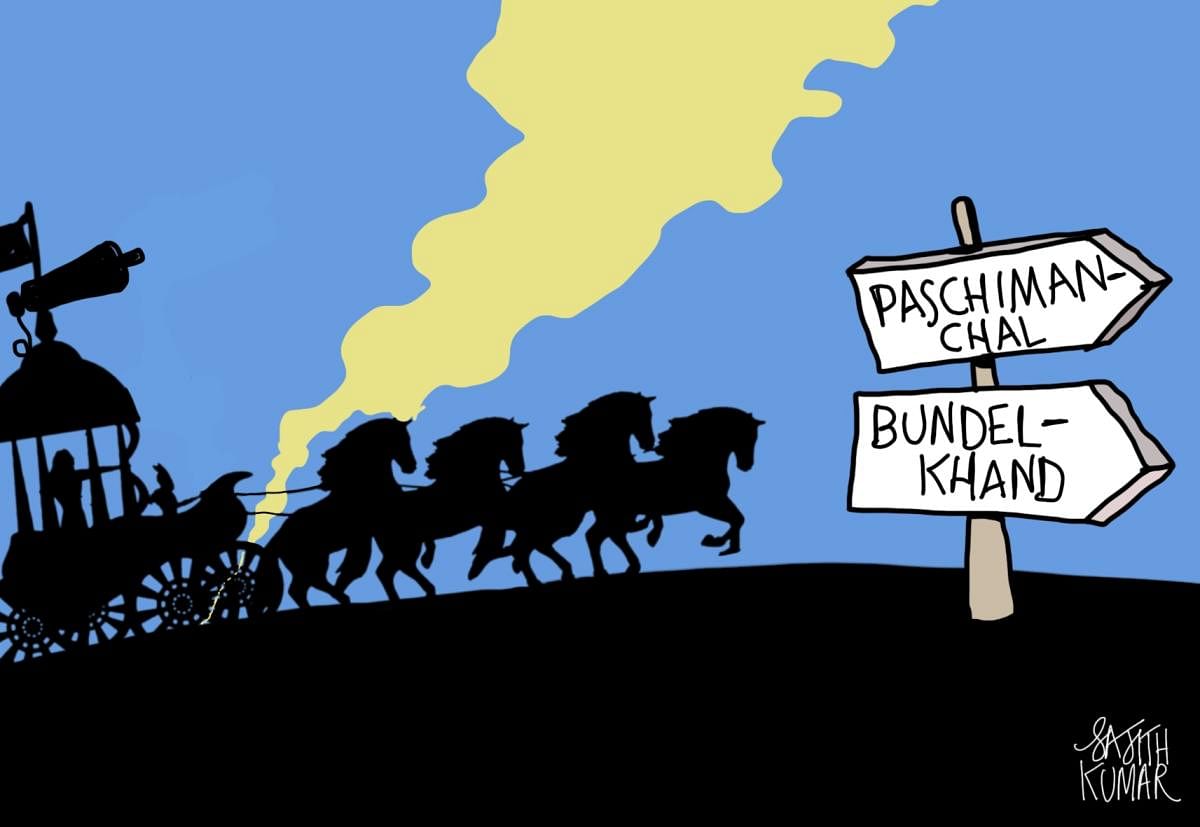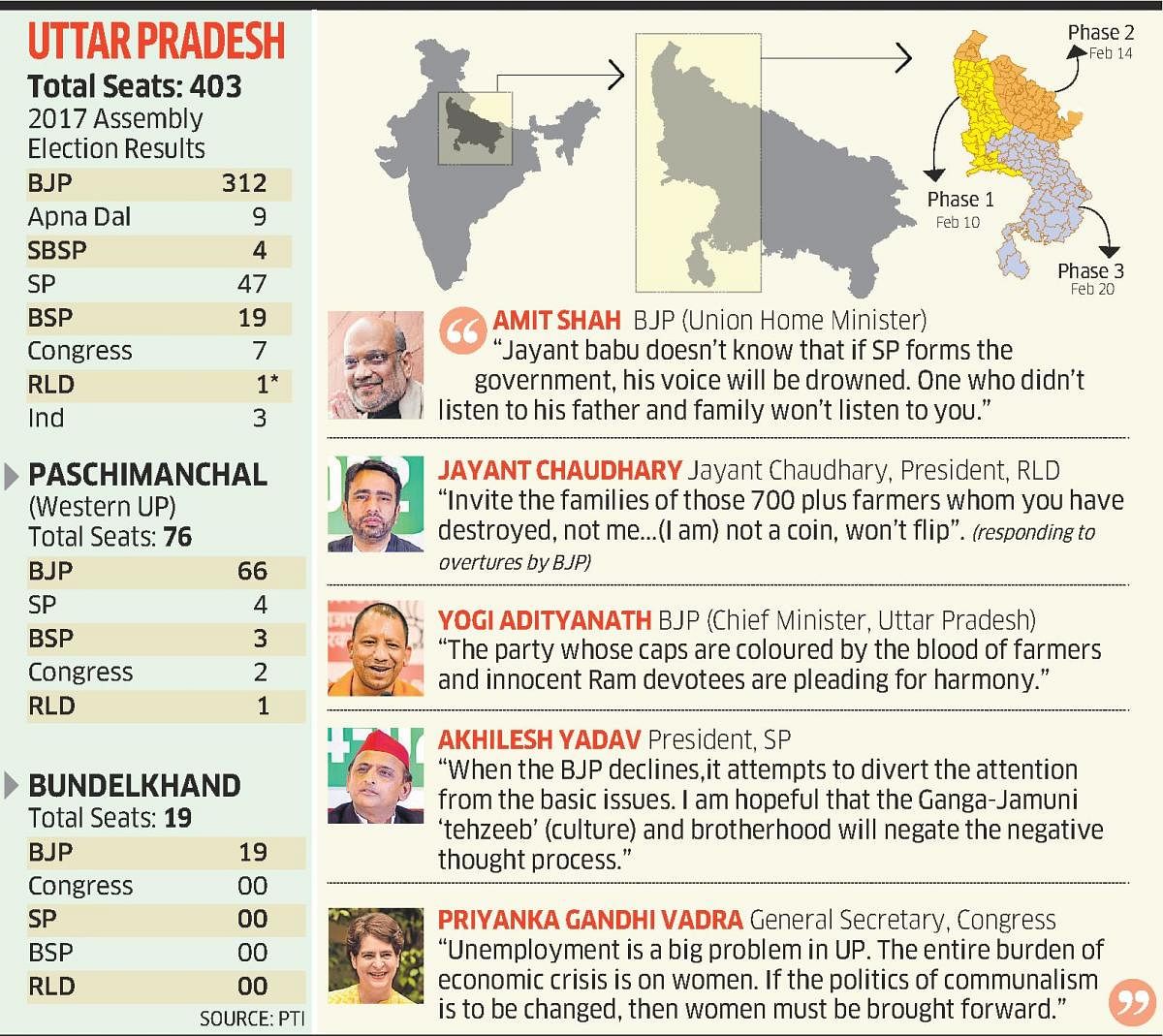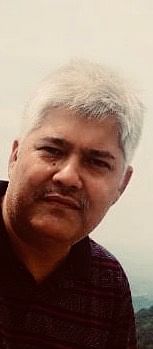

The Muslim Rashtriya Manch of the Rashtriya Swayamsevak Sangh issued a ‘Nivedan Patra’ to Muslims and is holding meetings with the community clerics, even as the Bharatiya Janata Party went full throttle with hardline Hindutva. Home Minister Amit Shah is repeatedly reaching out to Jayant Chaudhary of the Rashtriya Lok Dal, which already allied with the Samajwadi Party. Mayawati’s Bahujan Samaj Party has fielded a large number of Muslims as candidates in Paschimanchal – a move that might queer the pitch of other non-BJP parties. These are just some of the components of the conundrum that the assembly elections in Uttar Pradesh looks like as the stage is getting set for the first three phases of polling on February 10, 14 and 20 next.
The BJP, which had won 312 of of total 403 seats in the 2017 assembly polls, has tried to retain allies like Apna Dal and Nishad Party by giving them more seats, while the Opposition spectrum is divided with multiple claimants for the anti-incumbency votes against Chief Minister Yogi Adityanath’s government. The SP and its ally Congress had won just 47 and 7 seats respectively in 2017. Akhilesh Yadav’s party had tied up with the BSP in 2019 parliamentary polls when they could secure just five and 10 of the 80 Lok Sabha seats respectively. With the SP tying up only with the RLD and some smaller parties, the Congress and the BSP, which had won 19 seats in 2017, are going solo.
Also Read | All eyes on farmers
There are however indications of the Congress and the SP warming up to each other despite fighting separately. A video clip of Priyanka Gandhi Vadra and Akhilesh Yadav greeting each other while crossing path during an election campaign has gone viral on social media.
One of the new factors in play in 2022 polls are the year-long farmer agitation that ended in December 2021 only when the government finally agreed to repeal the three contentious farm laws. The other is the Covid-19, which exposed the failure of of the state health machinery, and the opposition latched on to the images of bodies floating in the rivers Ganges to hammer home the point that Yogi Adityanath failed when lives of people mattered.
The issues have been haunting the ruling BJP from the very beginning, particularly in Pashimanchal (Western UP) and Bundelkhand, which are going to polls in the first three of the seven phases of polling. The Samyuka Kisan Morcha, which had spearheaded the agitation against the farm laws, has decided to embark on ‘Mission Uttar Pradesh’, vowing to ‘punish’ the BJP. The ppposition parties are repeatedly referring to the incident in Lakhimpur Kheri, where four farmers were allegedly mowed down by an SUV incident October 3 last year. The son of a Union Minister son was booked in connection with the case.
Akhilesh Yadav, addressing a joint press conference with the RLD’s Jayant Chaudhary, went to the extent of saying that the first phase of polls is “farmers’ election” and it will set the tone for upcoming phases of polls too. The BJP leaders too intensified their outreach to the farmers, with the former Union Minister Sanjeev Balyan visiting the village of leader of farmer protest Rakesh Tikait, the state government celebrated ‘Kisan Divas’ in the memory of Jayant’s grandfather former Prime Minister Chaudhary Charan Singh.
The Modi Government’s 2022 Union Budget also talked of ‘Kisan drones”.
The poll-outcome in Western UP will largely depend on two factors, whether or not Jat consolidates in favour of the SP-RLD alliance and whether or not there is a divide in Muslim vote with BSP fielding a larger number of candidates from the minority community there.
While the ‘cacophony’ of ‘Gannah (sugarcane denoting farmers) and Jinnah (barb on SP for talking of Pakistan founder M A Jinnah) and ‘Mandir (Ayodya, Mathura, Kashi) versus ‘Kabristan’ reverberate in Western UP, the laboratory of BJP’s hardline Hindutva politics since 2013, it is back to basics in the backward Bundelkhand region with issues of irrigation, drinking water and employment resonating far from the state capital.
The poll discourse in parched Bundelkhand is revolving around ‘pyas’ (thirst) and ‘rozgar’ (employment).
Far from Hindutva or nationalism narrative, even social justice, this is ‘bijli paani sadak (power, water, road) election here. The BJP claims it’s government quenched the thirst of people here after the erstwhile SP government had obstructed implementation of the water supply plan of the Centre.
Prime Minister Narendra Modi had a few months back launched multiple irrigation projects in Mahoba. The projects are expected to help lakhs of farmers in four districts of the region besides improving the drinking water supply.
Unemployment is a major issue in Bundelkhand and migration for jobs to cities outside the region continues while the political blame game goes on. In November 2021, Modi laid foundation of the Rs 400-crore UP Defence Industrial Corridor (UPDIC) project in Jhansi.
Modi government in 2022 Budget announced the Rs 44000 crore Ken Betwa river interlinking project that is expected to help the arid regions of Bundelkhand get much needed water for agriculture in seven districts – Chitrakut, Banda, Jhansi, Jalaun, Hamirpur, Mahoba and Lalitpur in UP part of Bundelkhand.
Since 2007 state polls fiasco, when the BJP failed to win even a single seat, the party started promoting local leadership, won two seats in 2012 polls and ultimately bagged all the 19 seats in 2017.
Congress’ Priyanka Gandhi Vadra reminded voters of the Rs 3506 crore Bundelkhand package of 2011 announced by former Prime Minister Manmohan Singh for over-all development of the region and promised loan waiver to farmers. Taking her Ladki Hoon Lad Sakti Hoon campaign further, she launched ‘Aadhi Aabadi (half population) theme in Chitrakoot and addressed a rally in Mahoba, which was attended by a large number of women.
Most of the districts in the regions have high OBC population, going up to 62% in Banda. Dalit population in the districts ranges between 20% to 30%.
The BJP’s state president, Swatantra Dev Singh, an OBC leader from Kurmi caste, hails from Jalaun. Speaking in Jhansi, the BJP’s ally Apna Dal’s Anupriya Patel recently pressed for setting up of a dedicated OBC ministry, like the existing ministry for minority affairs, for the holistic development of the backwards.
Akhilesh Yadav’s Vijay Rath Yatra in October last year has set the tone for his SP’s campaign in Bundelkhand. But consolidation of non-Yadav votes in favour of BJP in a region, where Muslim votes do not matter much, could be troublesome for him as the Dalits largely rally behind the BSP in the region.
Check out DH's latest videos:
